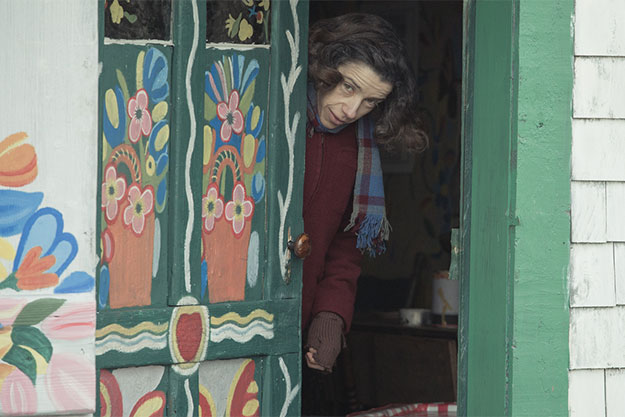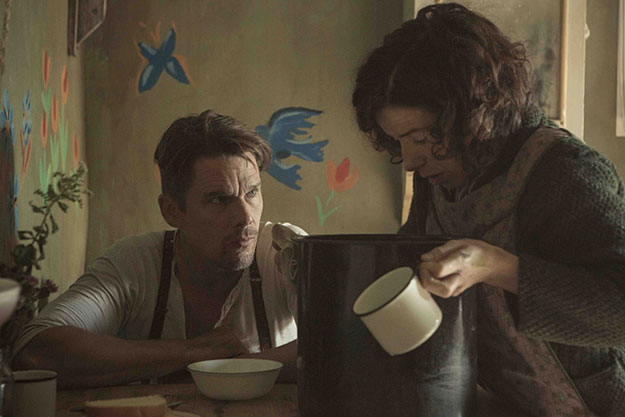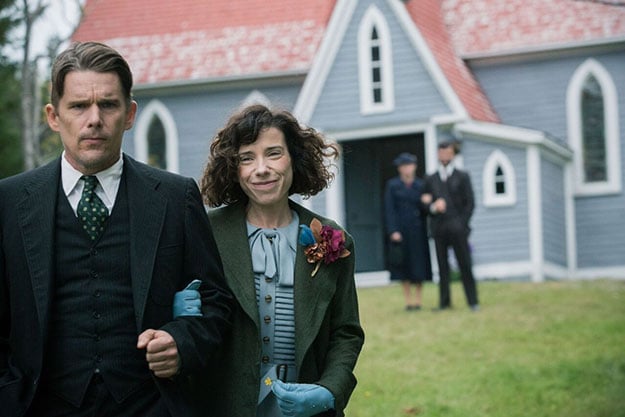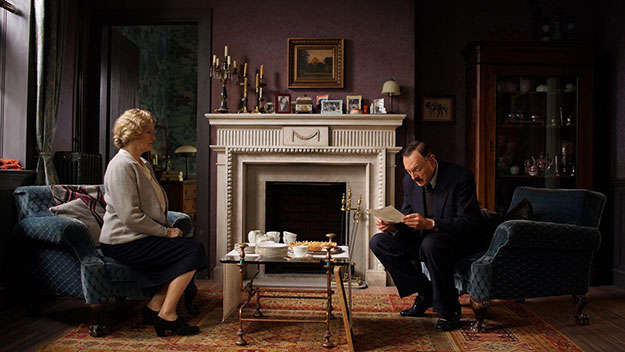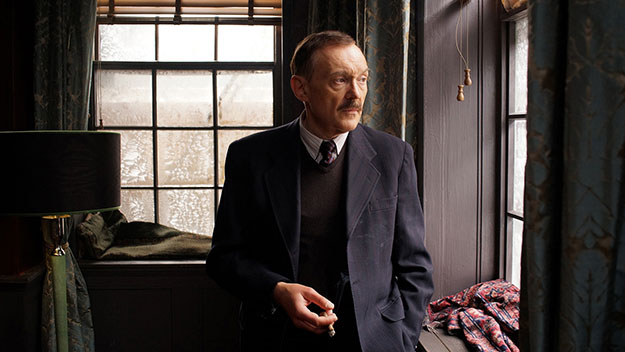Maudie The Nova Scotia painter Maud Lewis was a North American primitive, a self-taught folk artist who created eye-popping pastoral scenes from memory and imagination and by the end of her life was celebrated as a Canadian Grandma Moses. The Austrian writer Stefan Zweig could have been the archetype of the 20th century’s literary man of the world—a biographer, essayist, and fiction writer whose cosmopolitan sophistication rested on his humanistic dream of a unified Europe. Maud overcame physical deformations that sloped her shoulders, curled her fingers, and dropped her chin to her chest, as well as arthritis that stopped her from playing the piano and challenged her brush strokes. After her parents died, when she was in her thirties, the tyrannical condescension of her aunt and the callous neglect of her brother drove her to find a housekeeping job with a brutish, parsimonious fish peddler who eventually married her. The perspective of the movie Maudie is that they came to an instinctual understanding and stumbled into a way of life where she and her painting could thrive. Zweig, on the other hand, moved easily through society and for decades led a charmed literary life. Only Thomas Mann rivaled him in critical reputation or international readership. In the film, one admirer cries out that no other writer boasts Zweig’s understanding of women—a reference to novellas like the 1922 Letter From an Unknown Woman (the source of a sublime 1948 Max Ophuls film). Married twice to devoted and talented women, he was feted wherever he went, even after he pulled up his deep Austrian roots in 1934. Brazil, with its tropical splendor and mixed racial heritage, appealed to his sensuality and liberalism when he made it his new base half a dozen years later. But as a true believer in “the European man,” as well as a secular Jew and a peacemaker by nature, he couldn’t survive exile and his soul-quaking response to the outbreak of Nazism and World War II.
Maudie As these small releases meander out across the country, they’re worth seeking out, for the art they extol and the art they create. They contain marvels of composition and performance. Both movies use biographical elements to dramatize each protagonist’s quest to find a home, and in the process universalize some ultra-specific experiences. Pundits always say they’re hungry for individualistic work by talented female filmmakers. These are two estimable examples. Aisling Walsh’s Maudie follows Maud (Sally Hawkins) from 1938, when she leaves her aunt’s home to work as a live-in maid for Everett Lewis (Ethan Hawke), to her death in 1970, when her paintings were hanging in the Nixon White House. Maria Schrader’s Stefan Zweig: Farewell to Europe chronicles the wanderings of this urbane man of letters from 1936, when he first visited Brazil, to his death in 1942. Maudie takes its straightforward aesthetic from lines Sherry White’s script ascribes to its heroine: “I love a window. The whole of life already framed—right there.” To Maud there’s always a different view available of birds swooping or bees buzzing beyond her windowpane. For us, the same is true of Walsh’s forthright, square-cut views of Maud and “Ev” negotiating their domestic life in their roughhewn cottage or trekking across a lonely spit of land (the peninsula known as Digby Neck) to the general store in Marshalltown. In her Stefan Zweig movie, Schrader echoes Zweig’s own narrative method from his Decisive Moments in History (1927). She chooses six episodes that epitomize the last six years of his exile, depicting the ebb and flow of his resilience and the weight of relationships with colleagues and friends who desperately need help to escape the Third Reich. Reports of Europe’s collapse and millions dying permeate his psyche wherever Zweig (Josef Hader) goes: Rio de Janeiro, Buenos Aires, New York, the sugar-cane country of Bahia, and the picturesque Brazilian city of Petropolis, his final home, where he lives with his second wife, Lotte (Aenne Schwarz), who is also his secretary and researcher. In the course of his travels, Zweig is alternately toasted as an artist and pressured to use his fame to make sweeping political statements. He refuses, thinking it too easy and self-glorifying to condemn entire nations or to voice moral pronouncements from a safe place thousands of miles away from the carnage and the horror. He reaches the nadir of humiliation when he must listen to his name being read in a list of Nazi-persecuted authors at a PEN conference in Argentina. He buries his face in his hands out of embarrassment, not sorrow.
Maudie Each film does something singularly daring. Maudie celebrates a woman who wrests a strange yet somehow loving relationship from a man who initially slaps her and tells her she’s less important than his dogs or chickens (in that order). On their wedding night they picture each other as an odd pair of socks, but they’re considerably more peculiar than that. She identifies with Ev’s determination to maintain his independence no matter what. His eyes open up to her value when she starts selling her paintings. He grows to respect her and to see her as the only woman meant for him. They’re sometimes shockingly out of synch, but they usually catch up to each other’s needs and desires. Anyone who’s seen Mike Leigh’s Happy-Go-Lucky or Woody Allen’s Blue Jasmine knows how astonishing Hawkins can be at portraying a character whose cheerfulness is partly genuine and partly a matter of principle. In Maudie, we don’t think she’s slipped into denial when she weathers Ev’s solipsistic storms. She always credits Ev with her chance to create a life outside her aunt’s home, and she senses the pathos beneath his violence. Hawkins gives Maud a sturdy emotional spine and a psychological sonar that enables her to “read” the wild-eyed grimaces and incomprehensible mumbles of her misanthropic husband. From the beginning, Hawkins invests Maud with a naughty, rebellious streak and a quizzical, instinctive wiliness. Her smile is as broad as Mona Lisa’s is thin, but it’s just as rich and ambiguous. She sasses her propriety-ridden aunt and sees her brother for the selfish, feckless dolt he is. She manipulates her way into Everett’s house, swiping the job notice he posts at the general store, so she alone can apply. Maud and Ev may live in a rough two-story cottage, but Hawkins’s portrayal is an intricate, split-level construction. She suggests some magical, refractory device whirring from her brain to her fingers, melting all the seasonal hues into a bright primary-colored palette with brushstrokes that can make flowers and trees as well as cats and chickens seem ridiculously happy. As Ev, Hawke delivers a bold performance of a man in a perpetual state of siege. Visually, his performance evokes Walker Evans’s or Robert Frank’s portraits of North American working stiffs before everyone got used to being visible to the media. But Hawke’s acting goes beyond that first impression, conveying the panic of a man who carries around so many primal wounds that he can’t be sociable with anyone. (Ev’s parents abandoned him to an orphanage.) He puts up a wall of silent surliness when he isn’t grumbling or bellowing. Walsh shapes Hawkins and Hawke’s interplay so that the film registers as a bizarre-couple love story. Their romance attains its awkward balance when Maud maneuvers Ev into installing a screen door. These actors conjure a deep nonverbal bond that defies explanation.
Stefan Zweig: Farewell to Europe What’s audacious and subtly seductive about Stefan Zweig: Farewell to Europe is Schrader’s attempt to trace its hero’s pacific charm through highly charged public and private moments. This director shows off her knack for pomp and ritualized discourse in her masterly staging of a state lunch before a horserace in Rio, and the PEN conference in Buenos Aires. She puts a wonderful ironic cap on the episode of Zweig touring cane fields in Bahia: during the ensuing goodwill stop at a small-town mayor’s home, Stefan and Lotte listen with humor and a kind of pained nostalgia as a local band murders “The Blue Danube.” And Schrader shows her affinity for the intimate messiness of life during an afternoon with Zweig at his ex-wife’s borrowed apartment in Greenwich Village with her daughters (and one son-in-law), his current wife, and his American publisher. In the period covered by this movie, Zweig won acclaim for his biography Erasmus of Rotterdam (1934), which lauds the Dutch theologian’s insistence on reforming Catholicism from within as a paradigm of “the middle way.” Zweig espoused similar moderation in the face of Left and Right extremes. But Schrader doesn’t limn Zweig as a secular saint or depict his world view as inviolable. It sounds astonishing, but with the help of Hader’s uncanny, nuanced performance, we understand why grandstanding against Hitler offends Zweig to his core. He resists a blanket condemnation of Germany because he doesn’t believe in collective guilt. Though he’s racked with pain over the plight of his fellow Jews, he’s just as stricken that no one protests World War II simply as a war. The modest miracle of this movie is that, knowing what we do now, Zweig doesn’t register as absurdly narrow or fastidious. We see the heroism in his restraint and in his struggle to focus on his work. Even on the road, he’s always calling in favors from diplomats to find visas for people in distress. When his first wife Friderike (Barbara Sukowa) hands him a bundle of letters, we see what a burden his correspondence has become to him. Hader’s quickness and suppleness must stem from early years as a comedian. He gets across the mental agility needed to sustain a complicated domestic, professional, and artistic life in exile. And Schrader surrounds him with a suitably flexible and responsive ensemble. The warm, sturdy Sukowa and the fragile, soulful Schwarz are standouts as his two wives. His first overflows with shared experience, while his second fears the future and the living past.
Stefan Zweig: Farewell to Europe Schrader’s use of space is as expressive as her skill with actors. In one long, sustained shot of the table being set for the Foreign Minister’s lunch at the Jockey Club in Rio, she communicates the glory and absurdity of social elegance as vividly as anything in Wes Anderson’s tribute to Zweig, The Grand Budapest Hotel. In a screen-filling view of the land outside Petropolis, the lush tropical greenery swallows up the image of Zweig reading a newspaper: he doesn’t come into view until an old friend from home calls out his name. In one eloquent setup of him and Lotte in the back seat of a car, we get lost in his thousand-mile stare and her look of concern for him. When that shot is repeated, near the end of the film, a moment of shared merriment fades, and she, too, seems far away. At the close of Walsh’s Maudie, when Ev removes the “Paintings for Sale” sign from the front yard and shuts the door to his crude Nova Scotian cottage, it’s as if he’s marking the end of his happiness. In the heartbreaking finish to Schrader’s Stefan Zweig: Farewell to Europe, the vision we see reflected in a bedroom mirror in an airy bungalow brings home the destruction of Europe and the demise of a hyper-civilized way of life. The content may be sad, but the shape these directors sculpt from it transforms regret and grief into bracing and revitalizing art. Michael Sragow is a contributing editor to Film Comment and writes its Deep Focus column. He is a member of the National Society of Film Critics and the Los Angeles Film Critics Association. He also curates “The Moviegoer” at the Library of America website.
